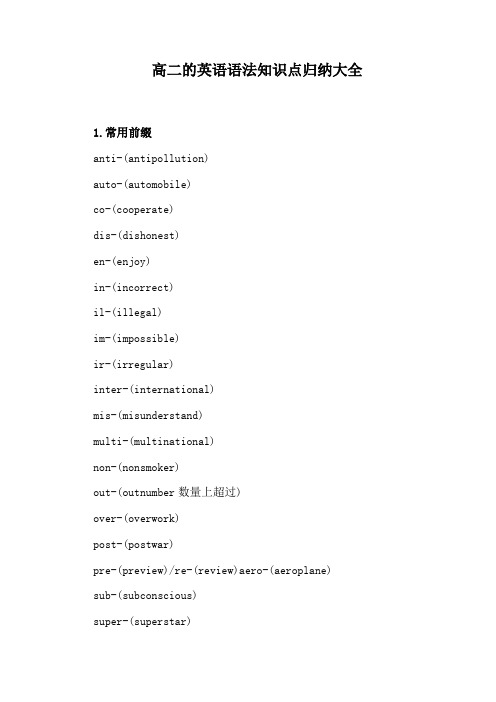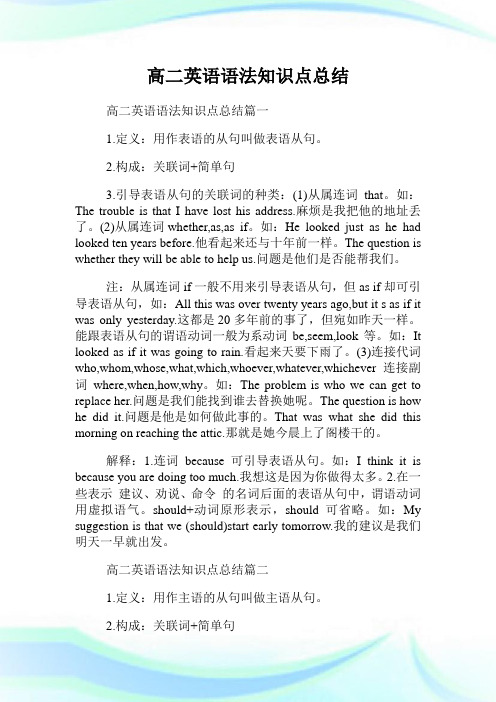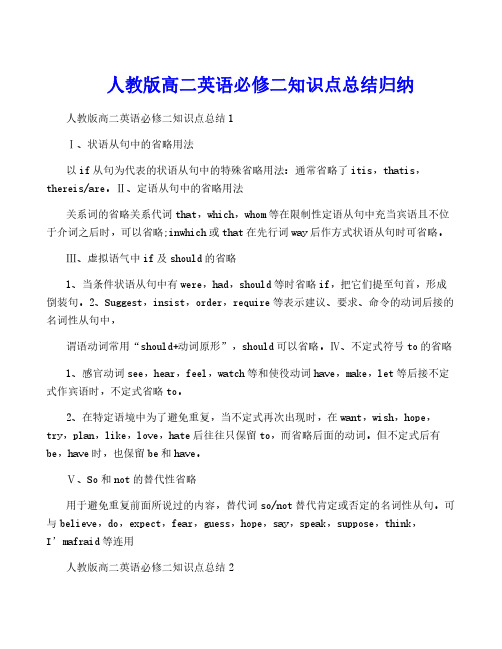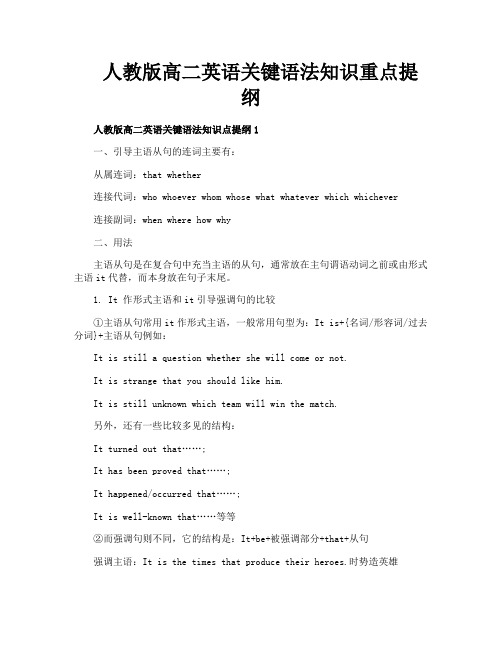人教版高二英语语法总结大全共8页
- 格式:doc
- 大小:64.50 KB
- 文档页数:8

高二的英语语法知识点归纳大全1.常用前缀anti-(antipollution)auto-(automobile)co-(cooperate)dis-(dishonest)en-(enjoy)in-(incorrect)il-(illegal)im-(impossible)ir-(irregular)inter-(international)mis-(misunderstand)multi-(multinational)non-(nonsmoker)out-(outnumber数量上超过)over-(overwork)post-(postwar)pre-(preview)/re-(review)aero-(aeroplane)sub-(subconscious)super-(superstar)tele-(telephone)un-(unlock)de-(decrease)/in-(increase)mini-(miniskirt)semi-(semicircle)self-(self-control,self-tauht)kilo-(kilometre)2.常用后缀-ability(capability)-ibility(possibility)-al(nationala./arrivaln.)-an(Eropean)-ian(musician)-arian(vegetarian)-ee(employee)/-er(employer) -or(actor)/-ss(actress)-ar(scholar)-hood(neighborhood)-ist(artist)-ese(Chinese)-ness(kindness)-y(difficultyn./noisya.)-ty(safety)-ity(activity)-th(wealth)-ence(different—>difference)-ance(ignorant—>ignorance)-dom(freedom) -ation(invite—>invitation)-tion(pollution)-sion(discussion)-ing(swimming)-ure(failure)-ment(development)-age(marry—>marriage)-ship(friendship,kingship)-ism(socialism)-ful(useful)-ive(act—>active)-ous(poisonous)-ly(friendly,quickly)-some(troublesome)-en(woodena./sharpenv.)-able(believable) -ible(responsible)-ize(modernize)-ward(backwardad.)-ify(beautify)UnitTwoWordFormation(Conversion&Compounding)1.Conversion(1)v./n.try,visit,work,search,guess,request,demand,change,swim,l ook,wash,seat,interest,aim,shout,kick,cry,desire,doubt,love etc.(2)a./ad.long,back,straight(3)a./n.wrong,good,rightpounding(1)homework,sunrise,headache,background,downtown,someone,no thing(2)guide-book,warm-hearted,well-known,good-looking,air-conditioned,left-handed(3)folksong,waterpipe,diningroom,postofficeUnitThreeTheStructureforEmphasisTheEmphatic–ItIt+be+被强调成份+that/who…Eg:1.BobwenttothetheatrewithJanelastSunday.->ItwasBobthat/whowenttothetheatrewithJanelastSunday. ->ItwaswithJanethatBobwenttothetheatrelastSunday. ->ItwastothetheatrethatBobwentwithJanelastSunday. ->ItwaslastSundaythatBobwenttothetheatrewithJane.。

高二英语语法知识点总结高二英语语法知识点总结篇一1.定义:用作表语的从句叫做表语从句。
2.构成:关联词+简单句3.引导表语从句的关联词的种类:(1)从属连词that。
如:The trouble is that I have lost his address.麻烦是我把他的地址丢了。
(2)从属连词whether,as,as if。
如:He looked just as he had looked ten years before.他看起来还与十年前一样。
The question is whether they will be able to help us.问题是他们是否能帮我们。
注:从属连词if一般不用来引导表语从句,但as if却可引导表语从句,如:All this was over twenty years ago,but it s as if it was only yesterday.这都是20多年前的事了,但宛如昨天一样。
能跟表语从句的谓语动词一般为系动词be,seem,look等。
如:It looked as if it was going to rain.看起来天要下雨了。
(3)连接代词who,whom,whose,what,which,whoever,whatever,whichever 连接副词where,when,how,why。
如:The problem is who we can get to replace her.问题是我们能找到谁去替换她呢。
The question is how he did it.问题是他是如何做此事的。
That was what she did this morning on reaching the attic.那就是她今晨上了阁楼干的。
解释:1.连词because可引导表语从句。
如:I think it is because you are doing too much.我想这是因为你做得太多。

人教版高二英语必修二知识点总结归纳人教版高二英语必修二知识点总结1Ⅰ、状语从句中的省略用法以if从句为代表的状语从句中的特殊省略用法:通常省略了itis,thatis,thereis/are。
Ⅱ、定语从句中的省略用法关系词的省略关系代词that,which,whom等在限制性定语从句中充当宾语且不位于介词之后时,可以省略;inwhich或that在先行词way后作方式状语从句时可省略。
Ⅲ、虚拟语气中if及should的省略1、当条件状语从句中有were,had,should等时省略if,把它们提至句首,形成倒装句。
2、Suggest,insist,order,require等表示建议、要求、命令的动词后接的名词性从句中,谓语动词常用“should+动词原形”,should可以省略。
Ⅳ、不定式符号to的省略1、感官动词see,hear,feel,watch等和使役动词have,make,let等后接不定式作宾语时,不定式省略to。
2、在特定语境中为了避免重复,当不定式再次出现时,在want,wish,hope,try,plan,like,love,hate后往往只保留to,而省略后面的动词。
但不定式后有be,have时,也保留be和have。
Ⅴ、So和not的替代性省略用于避免重复前面所说过的内容,替代词so/not替代肯定或否定的名词性从句。
可与believe,do,expect,fear,guess,hope,say,speak,suppose,think,I’mafraid等连用人教版高二英语必修二知识点总结2Practisemakingsuggestionsandexpressingopinions.练习提出建议并发表观点。
(p.17Goals2)practisevt.练习practise后面的动词一般要用-ing形式。
类似practise这种接动词-ing形式作宾语的动词还有:finish,enjoy,mind,giveup,can'thelp,suggest,keep等。

人教版高二英语关键语法知识重点提纲人教版高二英语关键语法知识点提纲1一、引导主语从句的连词主要有:从属连词:that whether连接代词:who whoever whom whose what whatever which whichever连接副词:when where how why二、用法主语从句是在复合句中充当主语的从句,通常放在主句谓语动词之前或由形式主语it代替,而本身放在句子末尾。
1. It 作形式主语和it引导强调句的比较①主语从句常用it作形式主语,一般常用句型为:It is+{名词/形容词/过去分词}+主语从句例如:It is still a question whether she will come or not.It is strange that you should like him.It is still unknown which team will win the match.另外,还有一些比较多见的结构:It turned out that……;It has been proved that……;It happened/occurred that……;It is well-known that……等等②而强调句则不同,它的结构是:It+be+被强调部分+that+从句强调主语:It is the times that produce their heroes.时势造英雄强调宾语:It is English that Prof.Lin teaches us.强调状语:It was in shanghai that I saw the film.判断是否是强调句有一个方法,就是将that以后的“句子的其余部分”拿出来单独看,看有没有缺成分,缺的是什么成分,再把谓语动词后面that前面的那部分,带到你认为缺成分的地方,如果放进去是一句完整的句子了,那就说明是强调句。

高二英语语法知识点总结十大精华吃透稳拿高分高二英语语法知识点总结!十大精华吃透稳拿高分!_动词_句子_从句高二英语语法知识点总结!学习英语的重要性无需赘述,作为全球通用语言,英语在我们的日常生活、学习和工作中扮演着重要的角色。
对于高中生来说,掌握好英语语法是提升英语能力的重要环节。
高二英语语法知识点总结:1、虚拟语气虚拟语气是表达一种假设、猜测、不确定或表达一种非现实的愿望。
在完成时态中,虚拟语气的基本形式是过去完成时。
例如:If I had known your phone number, I would have called you.2、情态动词情态动词表示推测、能力、可能性和必要性。
高二需要掌握的情态动词包括:can, could, may, might, must, shall, should, will, would等。
高中的知识点比初中多,课堂容量比初中大,一定要改变学习的被动局面。
我家的孩子就是通过高途根据应试教育理念,打造的高中课程,由辅导老师帮助点播和引导,学习思路会清晰很多,成绩大幅度提升。
3、被动语态被动语态是一种表达主语和谓语之间的关系,强调的是受动者。
在完成时态中,被动语态的形式是在助动词have之后加be动词的过去分词。
例如:The book has been read by me.4、非谓语动词非谓语动词是指在句子中不是谓语的动词,包括动词不定式、动词的-ing形式和动词的过去分词。
在高中英语语法中,非谓语动词的使用是一个重要的考点。
5、从句从句是在句子中起同样主语作用的一个短语或一组句子。
根据其在句子中的作用,从句可分为名词性从句、定语从句和状语从句。
高二需要掌握的从句包括:名词性从句(主语从句、表语从句、宾语从句和同位语从句)、定语从句和状语从句。
孩子学习上有困扰,一定不能置之不理。
我的孩子在高途做过规划,老师非常细心,学习提升不少,尤其《高途高考基础2000题》、《高途优卷》、《高中学习清单》等参考书很不错,辅助教材实用性强,一定要看!6、时态和语态时态和语态是英语语法中的基本要素,用于表达动作或状态发生的时间和方式。

人教版高中英语必修二重点词汇、短语、句型、语法大全Unit 1 Cultural RelicsKey Vocabulary and Phrases1.Survive: to remain alive。
to endure。
XXX2.In search of: looking for。
seeking3.Select: to choose。
to pick out4.Design: plan。
pattern。
concept5.Fancy: unusual。
peculiar。
imaginative6.Decorate: to adorn。
XXX7.XXX: to be a part of。
to be owned by8.In return: as a result。
in exchange9.At war: XXX10.Remove: to take away。
to relocate11.Less than: not as much as12.Doubt: uncertainty。
skepticism13.XXX: deserving of。
XXX14.Take apart: to dismantle。
to disassemble15.Explode: to burst。
XXX up16.Sink: to descend。
to XXX17.Think highly of: to have a high n ofKey Sentence Structures1.There is no doubt that…: It is XXX…2.When…: XXX.parisons: Used to compare one thing to another。
Can be within the same scope or XXX.4.The way…: Used to describe the manner in which something is done or explained.5.Worth: Used to describe the value or importance of something.6.“n word + to do” structure: Used as the subject。
人教版高二英语语法知识点英语语法是学习英语的重要一环,掌握好语法知识点能够帮助我们更准确、流利地表达自己的意思。
本文将为大家介绍人教版高二英语教材中的几个重要语法知识点,帮助大家更好地理解和运用。
一、时态时态是英语语法中的重要部分,表示动作发生的时间。
在人教版高二英语教材中,主要涉及到以下几个时态:1. 一般现在时 (Simple Present Tense)一般现在时用于描述经常性、习惯性的动作或者客观事实。
句子结构为主语 + 动词原形。
例句:- He usually goes to work by bus.- Water boils at 100 degrees Celsius.2. 一般过去时 (Simple Past Tense)一般过去时用于描述过去的某个时间里发生的动作。
句子结构为主语 + 动词过去式。
例句:- They visited their grandparents last weekend.- I lived in London for 3 years when I was young.3. 一般将来时 (Simple Future Tense)一般将来时用于描述将来要发生的动作或者事情。
句子结构为主语 + will + 动词原形。
例句:- I will meet you at the station tomorrow.- She will study abroad next year.二、从句从句是指在句子中作为句子成分的句子,分为主从复合句、名词从句、定语从句和状语从句等。
下面分别做简要介绍。
1. 主从复合句主从复合句是由主句和从句构成的复合句。
从句可以作为主句的主语、宾语、表语、定语或状语。
例句:- I think (that) he is a good student. (that引导的宾语从句)- It is important that we protect the environment. (that引导的表语从句)2. 名词从句名词从句是作为名词的从句,可以在句子中充当主语、宾语、表语或同位语等。
高二英语知识点人教版在学习新知识的同时还要复习以前的旧知识,肯定会累,所以要注意劳逸结合。
只有充沛的精力才能迎接新的挑战,才会有事半功倍的学习。
小编高二频道为你整理了《人教版高二英语知识点归纳》希望对你的学习有所帮助!高二英语知识点人教版1. Instead of spending your vacation on a bus, ... you may want to try hiking. Instead和instead 0f的用法2. Say "Hi" / "Hello" / "Thanks" to sb. (for me) 问候的句型3. Is anybody seeing you off? 进行时表将来4. She struggled and struggled, and could not get on her feet. (= keep struggling)5. You should not go rafting unless you know... unless引导条件状语从句,相当于if... not6. By staying at..., tourists can help the villagers make money so that they can take care of the fiver and the birds. 目的状语从句7. She was so surprised that she couldn't move. 结果状语从句8. Tree after tree went down, cut down by water. 过去分词作状语9. The next moment, the first wave swept her down, swallowing the garden. 现在分词作状语10. However, before she could think twice, the water was upon her. It didn't take long before the building was destroyed. before的用法高二英语知识点人教版动词不定式具有名词、形容词和副词的特征。
人教版高二英语语法知识点三篇在寻求真理的长河中,唯有学习,不断地学习,勤奋地学习,有创造性地学习,才能越重山跨峻岭。
高二英语下册语法知识点归纳1一、不定式做主语:1、不定式做主语一般表示具体的某次动作。
===动名词doing 表示习惯的,经常的动作。
e.g: To finish the building in a month is difficult.To do such things is foolish.To see is to believe. (对等)注: 1). 不定式作主语时,谓语用单数2). 当主语较长,谓语较短时,常用it做形式主语,而将不定式放到谓语的后面。
it做形式主语,不定式放在谓语动词之后常用于下列结构中:(1)It is/was +adj.+of sb. to do…(2)It is +adj.+for sb.+to do…It is easy / difficult / hard / foolish / unwise / right / wrong / unnecessary(3) it is +a +名词+ to do...It is a pity / a pleasure / a pleasant thing / one’s duty / an honor / a shame / a crime / no easy job… to doIt takes (sb.) some time / courage /patience …to do…It requires courage / patience / hard work… to do….注意: probable 和 possible 均可作表语,但possible可以用不定式作真实主语,而probable不能用不定式作真实主语。
It is probable for him to e to the meeting.(错)It is possible for him to e to the meeting.It is possible / probable that he will e to the meeting.人教版高二英语语法知识点归纳21. Instead of spending your vacation on a bus, ... you may want to try hiking. Instead和instead 0f的用法2. Say “Hi“ / “Hello“ / “Thanks“ to sb.(for me)问候的句型3. Is anybody seeing you off 进行时表将来4. She struggled and struggled, and could not get on her feet. (= keep struggling)5. You should not go rafting unless you know... unless引导条件状语从句,相当于if... not6. By staying at..., tourists can help the villagers make money so that they can take care of the fiver and the birds. 目的状语从句7. She was so surprised that she couldn #39;t move. 结果状语从句8. Tree after tree went down, cut down by water. 过去分词作状语9. The next moment, the first wave swept her down, swallowing the garden. 现在分词作状语10. However, before she could think twice, the water was upon her. It didn #39;t take long before the building was destroyed. before的用法高二英语必修三语法知识点总结31. cultural relics 文化遗产Many unearthed cultural relics were exhibited at the museum.博物馆展出了许多出土文物。
【高二学习指导】高二英语语法大全高二英语语法大全,供大家参考。
Unit One Word Formation(Derivation 派生词)1. 常用前缀anti-(antipollution)auto-(automobile)co-(cooperate)dis-(dishonest)en-(enjoy)in-(incorrect)il-(illegal)im-(impossible)ir-(irregular)inter-(international)mis-(misunderstand)multi-(multinational)non-(nonsmoker)out-(outnumber数量上超过)over-(overwork)post-(postwar)pre-(preview) /re-(review) aero-(aeroplane)sub-(subconscious)super-(superstar)tele-(telephone)un-(unlock)de-(decrease)/in-(increase)mini-(miniskirt)semi-(semicircle)self-(self-control, self-tauht)kilo-(kilometre)2.常用后缀-ability(capability)-ibility(possibility)-al(national a./arrival n.)-an(Eropean)-ian(musician)-arian(vegetarian) -ee(employee)/-er(employer) -or(actor) /-ss(actress)-ar(scholar)-hood(neighborhood)-ist(artist)-ese(Chinese)-ness(kindness)-y(difficulty n./noisy a.)-ty(safety)-ity(activity)-th(wealth)-ence(different—>difference)-ance(ignorant—>ignorance) -dom(freedom) -ation(invite—>invitation)-tion(pollution)-sion (discussion)-ing(swimming)-ure(failure)-ment(development)-age(marry—>marriage)-ship(friendship, kingship)-ism(socialism)-ful(useful)-ive(act—>active)-ous(poisonous)-ly(friendly,quickly)-some(troublesome)-en(wooden a./sharpen v.) -able(believable) -ible(responsible)-ize (modernize)-ward(backward ad.)-ify(beautify)感谢您的阅读,祝您生活愉快。
动词不定式的被动态,将来时,过去时,进行时、虚拟语气的结构 修辞倒装 1. Only在句首引导的状语从句表示强调要倒装。如果句子为主从复合句,则主句倒装,从句不倒装Only in this way can we learn English well. Only when one falls ill does one know the value of the health. 2.never等具有否定意义的词和词组居于句首要倒装。(紧跟否定词后的句子倒装,其他句子为正常语序。)常见的否定词有:never、rarely、seldom、little、hardly、not、nowhere等 常见的否定词组有:not until、not often、hardly…when、no sooner…than、neither…nor、not only… but also Little did I know that she had already left. 我一点也不知道她离开了。 Not often do they meet. 他们不常见面。 Not only is he rich but also he is very kind. ★*Not 放在句首修饰句子的主语,构成主语的一部分,则不需要倒装。 Not a word was said.Not a word did I say at the meeting. (not 修饰谓语动词) →I didn’t say a word at the meeting. 3. as / though引导的让步从句(就是as/though表“虽然、尽管”的意思)必须将表语或状语(形容词, 副词, 分词,动词,名词)提前 形容词Young as/thought she is, she has seen much of the world. 她虽然年轻,但却见过许多世面。副词Hard though he tried, he still failed. 他虽然努力了,但仍然失败了 动词Object hard as you may/do/will, I ' ll go. 纵使你反对,我也要去. ◆句首是实义动词, 其他助动词放在主语后。如果实义动词有宾语和状语, 随实义动词一起放在主语之前。分词:Situated as it was near the market, the house was very quiet. 房子虽然坐落在市场附近,但它很安静。 名词:Quiet student as he may be, he talks a lot after class. ◆句首名词不能带任何冠词,但可带定语. *”that”引导原因状语从句从句中的表语一定要用倒装。 Pretty that she is, she attracks many men. 因为她漂亮,因此她吸引了很多男人。 4.为加强语气,“so…that”的结构中的so, such放在句首是要倒装 He walked so fast that none of us could catch up with him. →So fast did he walked that none of us could catch up with him. 5.为使句子平衡,用倒装。 (1)主语较长,倒装表语On the floor were piles of books, magazines and newspaper. 地板上是一堆堆的书,杂志和报纸。Happy are those who are contented. 知足者常乐。 (2)倒装宾语以求强调What he did, I can’t imagine. Every word he spoke to her, she felt as a insult. 他对她说的每一个字,她都认为是侮辱。 6.为了生动地描写动作,“in, out, away, up, down,off”等副词可以放在句首倒装.用法与第一个相似.Away flew the bird! → The bird flew away. 鸟(一下子)飞走了 Off went Jack! → Jack went off. Jack去了. ★主语是代词,则用正常语序。 7.*某些习惯用法中的倒装.How goes it with you? 你好么?What mattered it? 这有什么关系?What care I? 关我什么事? 一.语法倒装1.当句首为here,there,now ,then,such,等副词,谓语动词为be, go, come等时要倒装。Here is the book you want. 你要的书在这儿。There goes the bell. 铃响了。Now comes your turn. 现在轮到你了。 ★当主语为人称代词,则不用倒装。 There he comes! 他来了!Here they are. 他们在这儿。Here it is. 给你。Behind the desk she stood. 他站在桌子后面。 2.The more……,the more结构的倒装。The more you study, the more you know. (宾语前置) 3.感叹句中的倒装How happy the children are! (表语前置) 4.表示次数,顺序的副词位于句首要倒装。 Twive within her lifetime has she been to England. 她一生已两次到过英国。 Next came a man in his forties. 下一个来的是一个40几岁的人。 5.与前面的句子相同,表示“也”,后面句子开头常用“so, neither, nor,either,no more”等引导的倒装句,并用do, have, be, can代替实义动词。 They can leave now, so can we. 他们现在可以离开了,我们也能。 You have helped her, and so has she you. 你帮助过她,她也帮助过你。 ★但是如果表示对前面句子的肯定则不用倒装。He is a good student, so he did. 他是个好学生,他的确是. 6.than或as引导的分句,表示两个句子的主语相比较时,要用倒装,用法与前一个相似. John will give you more than will Jack. Jonh给你要比Jack多. He travelled a great deal as did most of his friends. 他到过很多地方旅行,他多数朋友也是这样. 7.从句中关系副词的倒装He could tell where his home was. 8.well等表示方式,程度的副词位于句首要倒装。Well did I know her. 我很了解她。 9.有情态动词的谓语中,行为动词的倒装表示强调。Write a poem I can’t, let me write an essay instead. Unit 2高二语法讲义 不定式的语法作用 1) 不定式作主语: To see once is better than to hear a hundred times. 百闻不如一见。 To master a foreign language is not an easy thing. 掌握一门外语不是一件容易的事。 在很多情况下,人们通常用it作为形式上的主语,而把不定式短语移到谓语之后,使句子显得平稳一些。如:It’s good manners to wait in line. 排队等候是很有礼貌的。 It made us very angry to hear him speak to his mother like that. 听到他那样跟他妈妈说话我们很生气。2) 不定式作表语: The most important thing is to put theory into practice. 最重要的论付诸实践。The greatest happiness is to work for the happiness of all. 最大的幸福就是为大家的幸福而工作。3) 不定式作宾语: He wanted to know the truth. 他想知道真相。 I prefer to be starved to death rather than beg. 我宁愿被饿死也不愿乞讨。 He pretended to have read the book when I asked him about it. 我问到他的时候,他假装读过这本书。另外,不定式在某些复合宾语中作宾语时,人们常常用it代表不定式,而将真实宾语放在补足语之后。如: Do you think it better to translate it in this way? 你认为这样翻译是不是更好? I feel it a great honor to be invited to speak at the meeting before so many students. 我觉得被邀请在会上面对这么多学生发言是一件很光荣的事情。 4) 不定式作补语:①不定式可以和名词或代词一起构成复合结构作动词的宾语,这时不定式被称为宾语补足语。如:I would like you to help me with my English exercises. 我想请你帮我做英语练习。I never expected the shoes to be worn out so soon. 我从来没想到鞋子这么快就穿破了。注意:动词help后面接不定式作宾语或宾语补足语可以带to也可以不带to。如: Who can help me (to) carry this heavy box? 谁能帮我拎这个重箱子? ②在make, let, have等使役动词和see, watch, notice, hear, feel等感官动词后的复合宾语中,